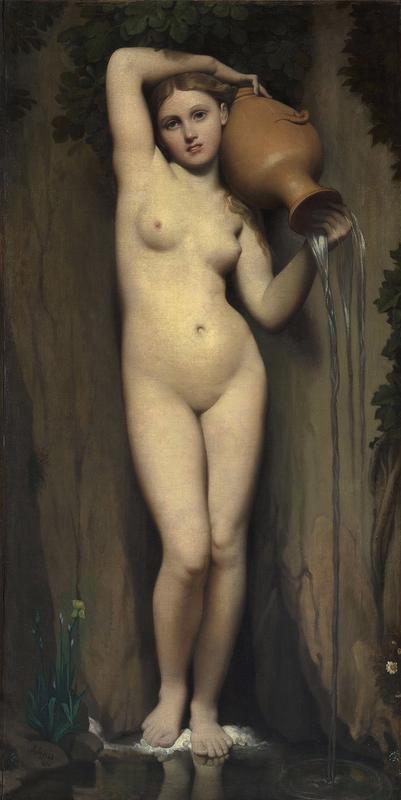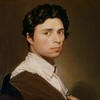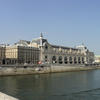More about The Source

Contributor
At the age of 76, Ingres unveiled La Source to enormous fanfare and a scene of collectors vying to purchase the painting.
There was a strange feeling about the painting because, as we will learn, the artist was not honest about his authorship. Ingres, relying upon his experience studying the works of both Raphael and his own teacher, Jacques-Louis David, had successfully distinguished his work from the styles of his contemporaries Géricault and Delacroix. Venus Anadyomene, an earlier ode to the pagan Greco-Roman Venus deity, had brought critical acclaim to the practice of Ingres. Like Warhol would do a century later, Ingres repeated the image, pulling the exact pose and body of the young woman, but changing the background and adding a water pot as a metonym for the woman. He called it La Source, and again it gestured back to pre-Christian times in Europe, when everyone worshipped feminine spirits for the propitiation of water.
The painting was such a hit that five people tried to purchase it from Ingres at the same time. The painter drew lots and sold it to the comte Duchâtel for 25,000 francs, which is at least $200,000 when adjusted for inflation. Nearly all the writing on La Source, especially during the artist's time, fawns over the painting as an example of pure aesthetic perfection, embodying "all the charms of virginity," as if such charms were universal. Of course, these are specifically the viewpoints of European middle-aged men seeking a nostalgic image of youth to momentarily distract them from their own lives. Marcel Proust's novelistic use of La Source, while again positive, adds a refreshing irony: "By the way, you seem quite keen on these paintings. If I had known that, I would have responded to you. Moreover, there is no need to overexert yourself to appreciate the painting of Mr. Elstir as if it was The Source of Ingres or the Enfants d'Édouard of Paul Delaroche. What you appreciate in it is that it is a fine observation, amusing, and Parisian, and then you continue on. You don't need to be a scholar to look at it." By flipping his praise for Ingres on its head, making it the foil to his character's dismissal of the paintings of M. Elstir, Proust manages to enter a popular discussion of La Source without sounding like everybody else.
Madeleine Dobie suggests that the nude female forms of Ingres originate in his studies of the "Levantine or Persian harem woman," making his portraits of women Orientalist, regardless of the skin color or physical features of the women in the paintings. Dobie places the work of Ingres within the historical milieu of the transatlantic slave trade, which drove a desire for representations of light-skinned Arab or Jewish "Oriental" slave women, driven by a simultaneous desire to dignify and disavow the practice of slavery and find a sensual thrill in the image of a young apparently "white" woman alone, without any defense. Dobie deftly pairs this observation with a focus on the psychopathological, voyeuristic nature of both the paintings themselves and the desires of the collectors.
Sources
- Clark, Kenneth. The Nude: A Study in Ideal Form. Princeton: Princeton University Press, 2015.
- CPI Inflation Calculator, https://www.officialdata.org/1850-dollars-in-2017?amount=5000.
- Dobie, Madeleine. "Embodying Oriental Women: Representation and Voyeurism in Montesquieu, Montagu and Ingres." Cincinnati Romance Review (1994): 51-60.
- Eaton, A.W. "'What’s Wrong with the (Female) Nude?' A Feminist Perspective on Art and Pornography." In Aesthetics and the Philosophy of Art: The Analytic Tradition, An Anthology, edited by Peter Lamarque and Stein Haugom Olsen, 287-288. Hoboken, NJ: John
- Naef, Hans. Portraits by Ingres: Image of an Epoch. New York: Metropolitan Museum of Art, 1999.
- Proust, Marcel. Marcel Proust : Oeuvres complètes — Les 40 titres et annexes (Nouvelle édition enrichie). Paris: Arvensa editions, 2015.
- Quora, https://www.quora.com/What-was-a-Franc-worth-in-todays-terms-during-the….
- The Count de Soissons. The aesthetic purpose of byzantine architecture and other essays. London: Murray & Evenden, Ltd., 1914.
Featured Content
Here is what Wikipedia says about The Source (Ingres)
The Source (French: La Source, meaning "The Water Source or The Spring") is an oil painting on canvas by French neoclassical painter Jean-Auguste-Dominique Ingres. The work was begun in Florence around 1820 and not completed until 1856, in Paris. When Ingres completed The Source, he was seventy-six years old, already famous, and president of the École des Beaux-Arts. The pose of the nude may be compared with that of another by Ingres, the Venus Anadyomene (1848), and is a reimagination of the Aphrodite of Cnidus or Venus Pudica. Two of Ingres' students, painters Paul Balze and Alexandre Desgoffe, helped to create the background and water jar.
Check out the full Wikipedia article about The Source (Ingres)












